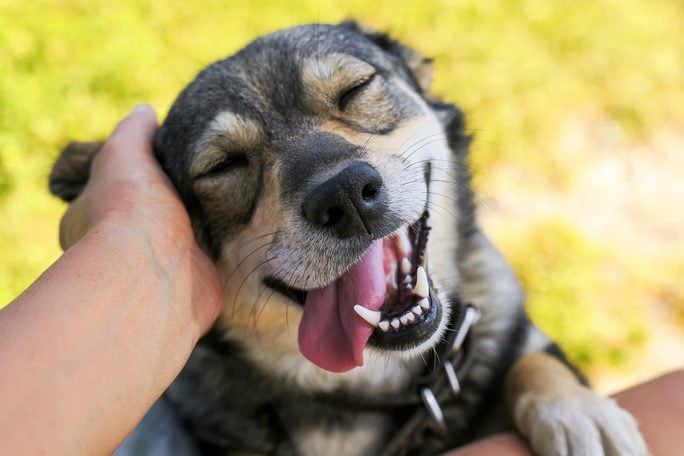
Decoding your dog’s happiness
Of course, we want our pups to be happy from head to tail, but what does happiness look like in dogs? Dog behavior is complex, so it can be hard to tell how our pups feel, whether happy, unhappy or somewhere in between. According to a report published in Frontiers in Psychology, research on positive dog emotions like happiness is somewhat sparse. So you might wonder, How do I know if my dog is happy?
“Happy dogs look happy,” says Marc Bekoff, PhD, an expert animal behaviorist and professor emeritus of ecology and evolutionary biology at the University of Colorado. And while that may be true, remember: You know your dog better than anyone. “Any interpretations of dog behavior depend on each dog’s personality,” he says. “There often aren’t cut-and-dry answers, so knowing your dog’s personality will help you know their feelings.”
When I was growing up, for instance, our dog would get the zoomies when he was happy—85 pounds of a Labrador-greyhound-Doberman mix zipping around the Ping-Pong table. But while full-fledged elation may be obvious, other signs of happiness are a bit trickier to spot. Thanks to Bekoff’s knowledge of canine emotions (and my many years of veterinary experience), we’re demystifying dog happiness. Ahead, we’ve covered 12 of the most common signs of happiness in dogs.
Get Reader’s Digest’s Read Up newsletter for more pets, humor, travel, tech and fun facts all week long.
About the experts
Reviewed for accuracy by: Wailani Sung, DVM, a vet with a board certification in veterinary behavioral medicine who owns Bay Area Vet Behavior. Dr. Sung is the co-author of From Fearful to Free: A Positive Program to Free Your Dog from Anxiety, Fears and Phobias. |
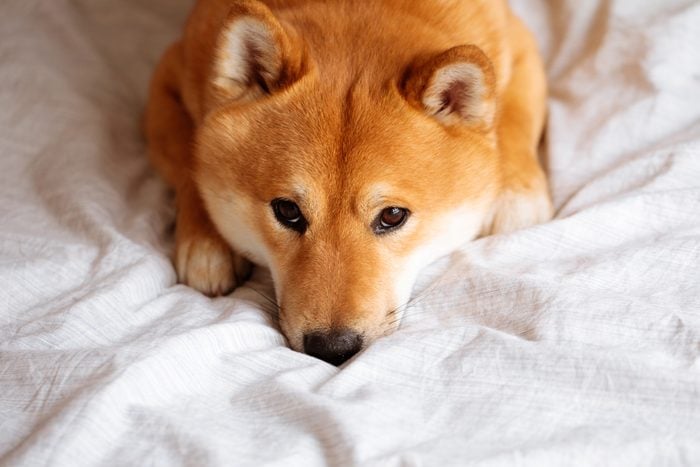
Soft, relaxed gaze
Your dog’s facial expressions can say a lot about how they’re feeling. A happy dog, for instance, has a soft gaze with eyes opened wide, Bekoff says. They may also blink their eyes frequently.
And here’s some good news: That soft gaze can mean love and affection and has the power to stimulate the release of oxytocin (the love hormone) in its owner as well. According to a study published in Science, oxytocin strengthens the affectionate bond between you and your dog. And when dogs stare at us, our level of the love hormone increases, which increases dogs’ oxytocin in turn.
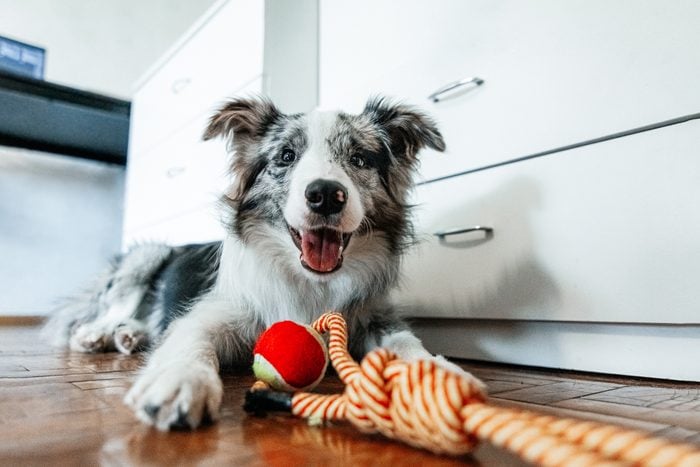
Happy facial expression
A relaxed, open mouth with a lolling tongue can indicate dog happiness. According to Bekoff, happy dogs have loose jaws and may look like they’re smiling with the corners of their mouth turned up. A happy dog may also show their teeth when their mouth is open and relaxed, but not in a way that indicates aggression (bared teeth, lips curled back).
Additionally, a happy dog whose mouth is open and relaxed likely has a relaxed body posture without heavy or rapid breathing, so it shouldn’t be confused with panting. Panting in dogs may indicate overexertion, anxiety or medical conditions that need attention.
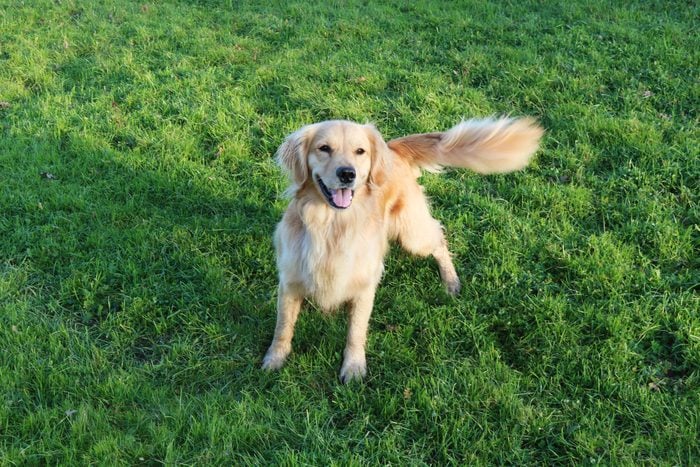
Tail and body wagging
How do you know if your dog is happy? Check the tail. A gentle, loose tail wag can indicate happiness in a dog. Dogs that are feeling happy may wag their tail slowly and widely from side to side, with their tail in a neutral position or slightly raised. In contrast, a dog that’s feeling aggressive will wag their tail quickly, with their tail arched over their back. An anxious dog will wag their tail to the left.
But just make sure to observe your dog’s tail wag in context with other emotional cues, such as posture, gait and facial expression. “Using a wagging tail as a sole indicator of a dog’s emotional state can be tricky,” cautions Bekoff. For example, if your dog’s tail wag suggests aggression and your dog is baring their teeth, your dog is feeling aggressive rather than happy. On the other hand, if your dog has a loose, gentle and slow tail wag and has a happy-looking facial expression (soft gaze, relaxed mouth), your dog is probably feeling pretty happy. Looking at these cues together “is a more reliable indicator of what a dog is feeling,” he says.
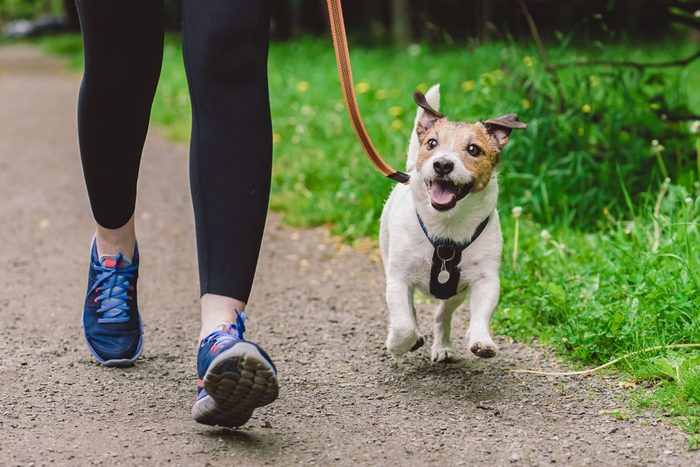
Loose, bouncy stride
When out for a stroll, a happy dog is at complete ease with fully relaxed muscles. During a walk, a dog that’s feeling happy will have a loose, bouncy and smooth gait, says Bekoff. It will also display normal dog behavior, such as sniffing at plants and flowers and engaging with other friendly dogs and passersby.
Happy dogs take their time to explore everything around them during their walks, enjoying every moment. Poor leash manners, such as tugging at the leash and walking far ahead of you instead of at your side, shouldn’t be an issue if your dog feels happy during a walk.
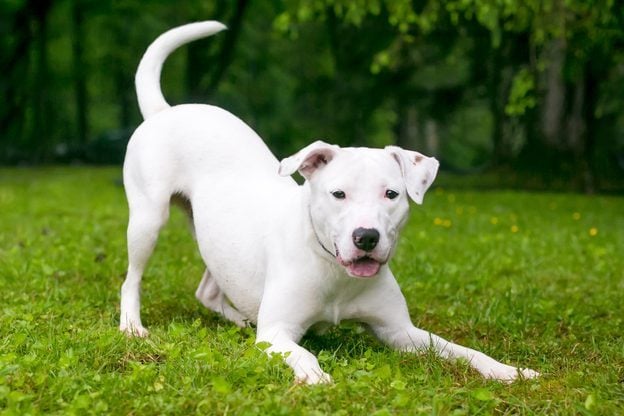
Play bow stance
Dogs in a happy, playful mood may scooch their chest down to the floor with their bottom in the air. This stance is called a play bow. They will do this before a play session to signal that they are ready to play and want to play with you! They can also display this stance during a play session to indicate that they want to continue playing.
Overall, with the play bow, your dog is bursting with energy and would love to engage in active play, such as fetch. Although dogs can play roughly with each other, a playful stance does not signal that your dog wants to play roughly with you. They simply want to be active and have a good time.
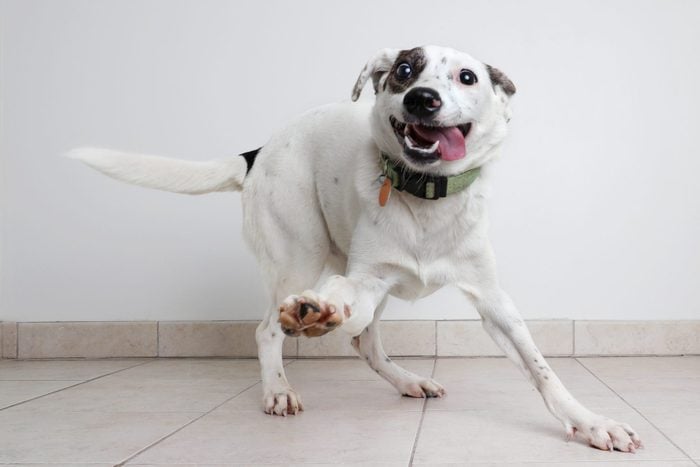
Happy dancing
“I call the happy dance a happy wiggle, when a dog has a loose and bouncy gait and looks like they’re put together with rubber bands,” says Bekoff. With the happy dance, a dog may also hop excitedly and quickly from side to side, as if they’re jumping on a trampoline. Happy dogs with this dance are moving their whole bodies, indicating they’re feeling happy all over and want to share that happiness with you.
“They might also lie on their stomach and slowly creep or slide toward a potential play partner,” Bekoff says. That play partner is probably you!
This happy dance is not specific to certain breeds. However, because dogs have individual personalities and temperaments, not all dogs that are feeling happy will do the happy dance. A more laid-back happy dog may be content with a tail wag or soft gaze to show how they’re feeling.
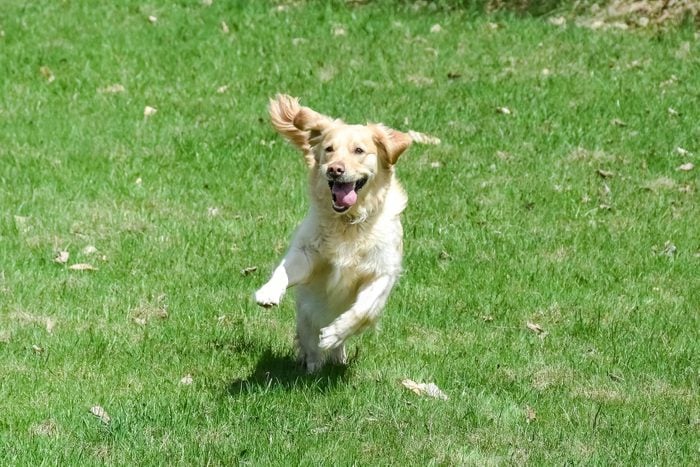
Zoomies
When our dog started racing around the Ping-Pong table, we knew he was experiencing pure happiness. When a dog gets the zoomies (yes, that’s the technical term), they are experiencing random bursts of enthusiasm to release pent-up energy. This excess energy can come from excitement, such as seeing a favorite family member come home or when their bath is over.
On the other hand, dogs can get the zoomies if they’re feeling anxious or uncomfortable. But if your dog starts zooming around the yard or in your home while also displaying other signs of happiness, you can rest assured that they’re happy and living their best life.
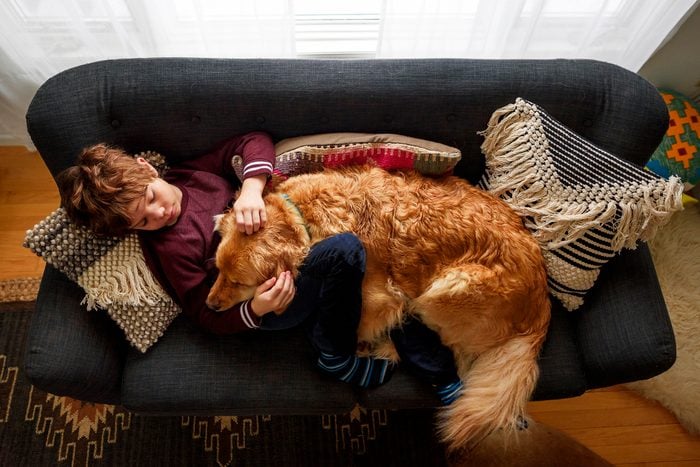
Physical contact
Who doesn’t love a relaxing cuddle session with their dog? Happy dogs seek physical contact with their owners, like snuggling up to you on the couch or nudging your hand for a pat on the head. Our dog would love to lean his entire body against us when he felt happy and wanted to be close.
Every dog is different though, so keep in mind that not every happy dog will want to cuddle or otherwise be close to their owners. Even for the happy dogs that love physical contact, they’re not necessarily looking for hours of closeness; just a few minutes may be enough to satisfy their want to be close to you.
A dog that’s feeling happy but wants to be alone isn’t a cause for concern. However, if your dog prefers to be alone and is showing signs of unhappiness or depression, such as changes in eating and sleeping behavior, consider taking your dog to the vet for further evaluation.
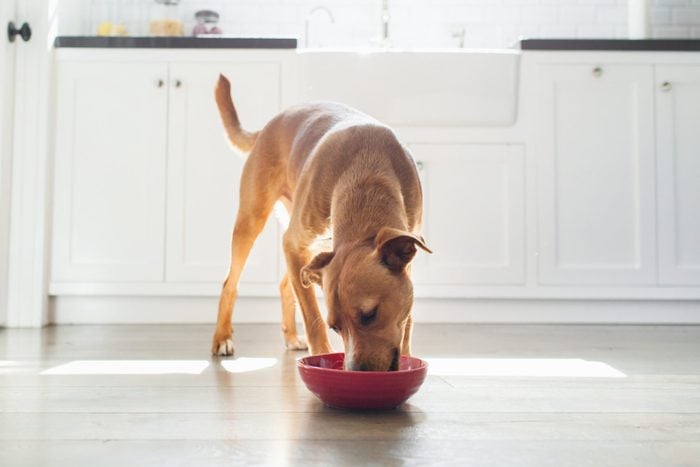
Normal appetite
A happy dog has a good appetite and will eagerly chow down at mealtime. “Like us, dogs feel better and are less grouchy when their belly is full,” says Bekoff. A reduced appetite or refusal to eat could signal a physical or emotional health issue that warrants attention.
As with many other dog behaviors, every dog has their own eating habits and appetite. For example, some dogs may knock you over to get to their food bowl, while other dogs may graze on a few bits of kibble when the mood strikes. Although eating well can indicate a happy dog, it is not a surefire sign of happiness.
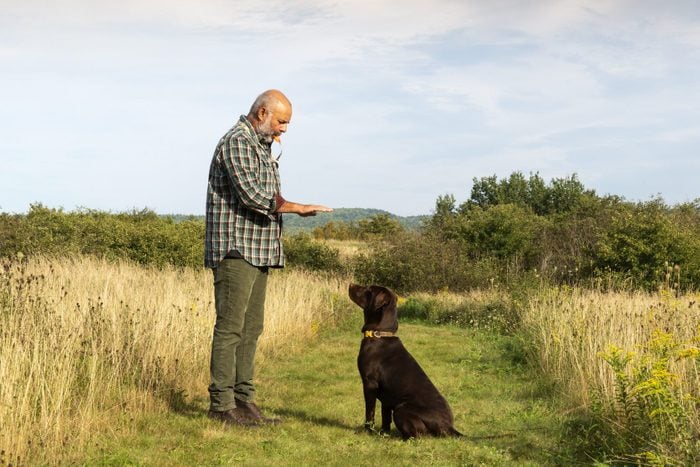
Good behavior
How do I know if my dog is happy? Happy dogs are less likely to engage in destructive behavior, such as chewing on your shoes or tearing up the pillows when you’re away from home. But that doesn’t mean that your happy dog won’t get into some mischief. For example, a puppy that’s eager to explore their environment may see your couch cushion as the perfect object on which to chew and strengthen its jaw muscles.
Our dogs don’t see what they’re doing as destructive or bad, so take a moment to recognize good and bad behavior. Good behavior can be thought of as the positive behaviors we want our dogs to perform, such as following basic commands (“sit,” “stay”), going to the bathroom outside and staying by our side while on the leash. Bad behaviors are undesirable behaviors, like biting and peeing in the house.
Bad behaviors don’t automatically mean that a dog is unhappy. But a dog that usually behaves well but starts misbehaving could signal a deeper problem, such as separation anxiety, which can be managed with behavioral modification and, if necessary, anti-anxiety medication.

Sufficient sleep
Have you ever felt grouchy or unhappy after not getting enough sleep or having your sleep disrupted? Our dogs can feel that way too, says Bekoff. Happy adult dogs get plenty of sleep, about 12 hours daily. “Sleep is essential to dogs, just as it is for us,” says Bekoff. Sleep has numerous benefits for dogs, such as helping with brain development and memory and supporting a healthy immune system. Sleep also helps dogs, especially puppies, recover from a full day of play and other physical activity. Overall, adequate sleep is important for dogs to maintain good physical and mental health.
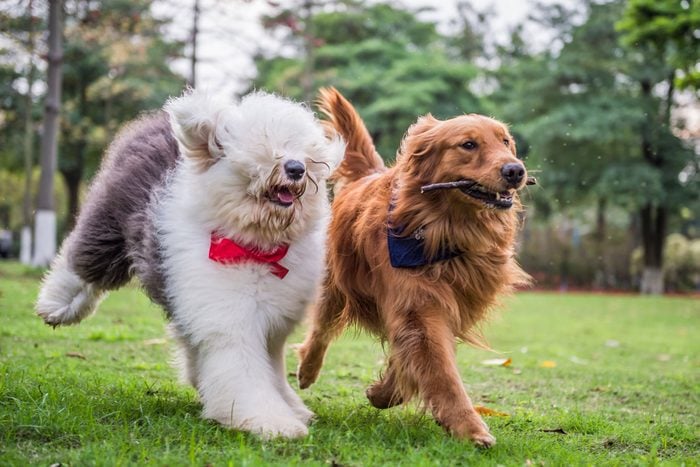
Friendly and social demeanor
Are you wondering, Is my dog happy? Happy dogs enjoy hanging out with other friendly dogs and people. If your dog enjoys social interactions like running around the dog park with other pups, you can be confident your dog is happy and feeling good.
That being said, some dogs are perfectly content by themselves when they’re feeling happy. They don’t need to make a jaunt to the nearest dog park or have a doggy play date. If your dog is happy but doesn’t feel like being around other dogs or people, there is no need for concern. In fact, some breeds, such as greyhounds, basset hounds and Bernese mountain dogs are more independent and prefer to keep to themselves. If you have one of these breeds, their desire to be left alone is not necessarily an indication of unhappiness.
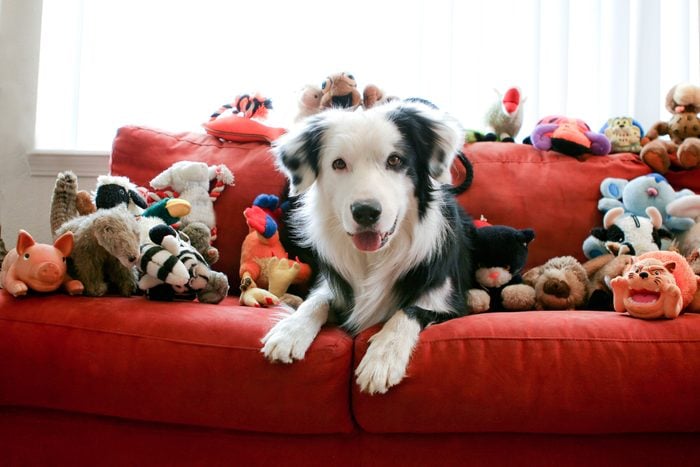
How can you make your dog happier?
Wanting to make your dog happier comes from a place of deep love. Your dog won’t necessarily understand the words, “I love you,” but your actions, including satisfying their needs and spending quality time, can communicate that love.
“It’s difficult to know if our dogs can feel we love them,” says Bekoff. “But it’s safe to say that when they feel safe and trust that their guardians have their best interests in mind, they will feel your love.” Want to make your dog happier? Here are some suggestions.
- Give them freedom. “Give your dog as many choices as possible, and don’t over-control them or be a helicopter guardian,” says Bekoff. “These choices can include a variety of toys and interactive play activities. The more freedom a dog has, the happier they will be.”
- Provide alone time. Even happy dogs need some alone time to rest. “If your dog needs it, give them some time to themselves and don’t take it personally,” Bekoff says.
- Give them lots of attention and love. “Don’t be afraid of spoiling your dog,” says Bekoff. Do you want to splurge on a fun dog toy you saw at the store? Go for it!
- Ensure you and your dog are on the same page. “Pay close attention to what your dog is telling you they need and if they consent with what you ask of them,” says Bekoff.
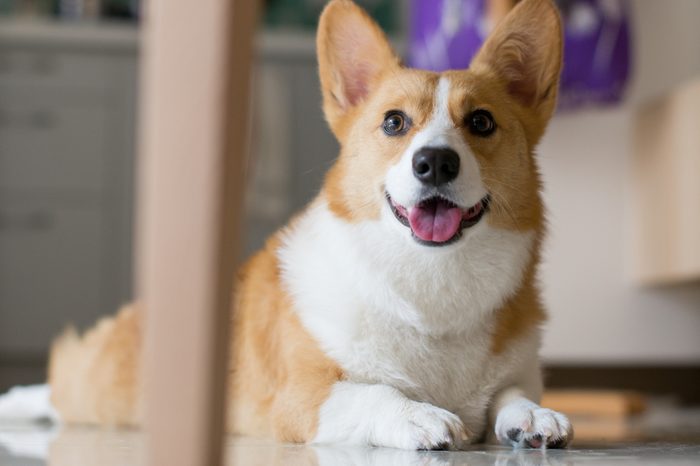
FAQs
How do I know if my dog is unhappy?
“Dogs differ in how they express unhappiness,” says Bekoff. They might have low energy, seem uninterested and unenthusiastic or have a dragging gait. Dogs that feel neglected by not getting enough play time or not having their needs met will likely feel unhappy. Bekoff emphasizes the importance of observing your dog to understand their unique behavior patterns.
Are some breeds happier than others?
Breeds certainly have unique traits and quirks, but it would be a stretch to say that some breeds are happier than others. Individual dogs within any breed will have different personalities and behaviors. You can find happy (and unhappy) dogs within any breed.
Why trust us
At Reader’s Digest, we’re committed to producing high-quality content by writers with expertise and experience in their field in consultation with relevant, qualified experts. For this piece, JoAnna Pendergrass, DVM, tapped her experience as a veterinarian and freelance medical writer, and then Wailani Sung, DVM, a veterinarian who owns Bay Area Vet Behavior, gave it a rigorous review to ensure that all information is accurate and offers the best possible advice to readers. We verify all facts and data, back them with credible sourcing and revisit them over time to ensure they remain accurate and up to date. Read more about our team, our contributors and our editorial policies.
Sources:
- Marc Bekoff, PhD, animal behaviorist and professor emeritus of ecology and evolutionary biology at the University of Colorado; email interview, March 20, 2024
- Frontiers in Psychology: “Where do we stand in the domestic dog (Canis familiaris) positive-emotion assessment: A State-of-the-Art review and future directions”
- Psychology Today: “Why Dogs’ Happiness Matters”
- Journal of the American Veterinary Medical Association: “Review of epidemiological, pathological, genetic, and epigenetic factors that may contribute to the development of separation anxiety in dogs”
- Science: “Oxytocin-gaze positive loop and the coevolution of human-dog bonds”

